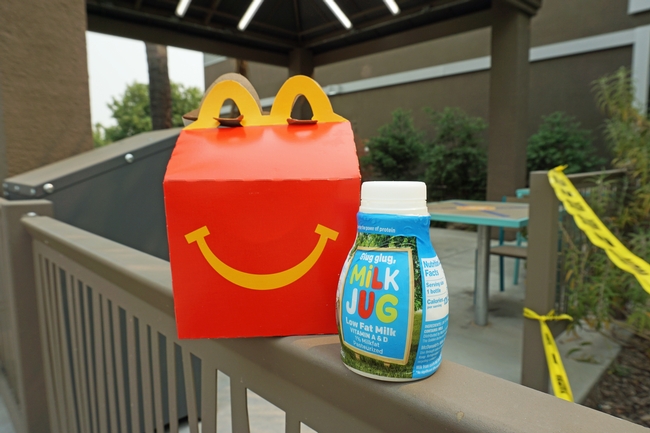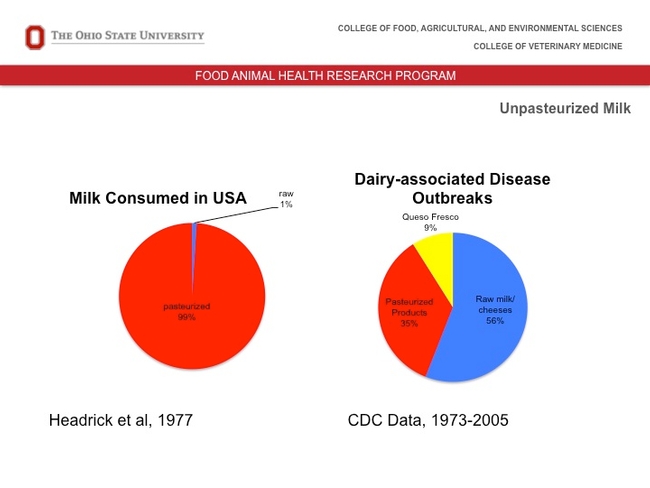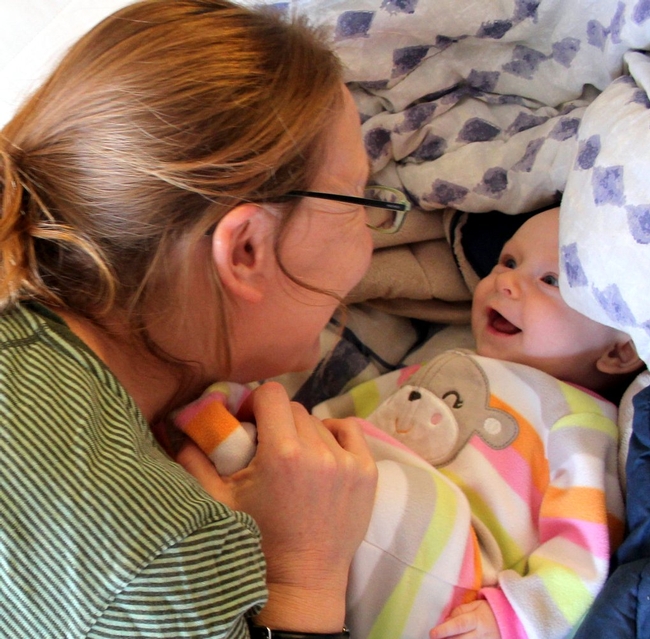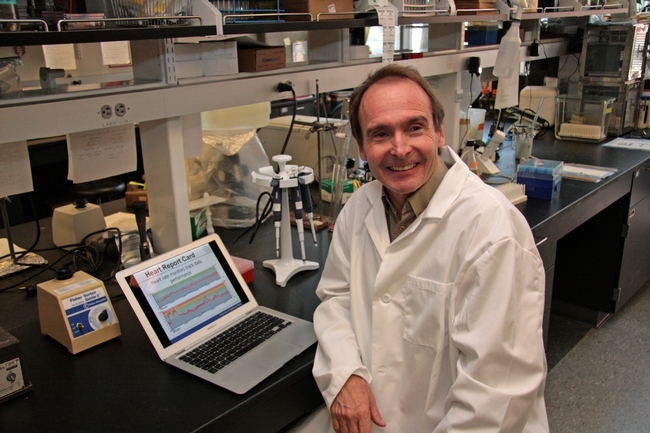Posts Tagged: milk
New policies can inspire families to provide healthy beverages to children
At fast food and sit-down restaurants across California, kids' meals come with water or milk automatically. At least, that should be the case since state law requires restaurants to offer the healthy beverages by default to reduce the amount of sugary beverages served to children.
California Senate Bill 1192, authored by Sen. Bill Monning (D-San Luis Obispo), went into effect Jan. 6, 2019, but research by the UC Nutrition Policy Institute (NPI) has found that implementation has not been universal and more can be done. The results, along with results from a similar study in Wilmington, Del., were published Aug. 20 on HealthyEatingResearch.org.
Before the law, 10% of menu boards observed by the researchers in California listed only the healthy beverages. Data collected after the law went into effect showed 66% of menu boards list the healthy default beverages. The researchers also collected data on the proportion of cashiers who verbally offered only healthy beverages with kids' meals when orders were placed. This happened only 5% of the time before the law was enacted, and dropped to 1% after.
“Parents look at menu boards and kids look at menu boards, but it is likely that what the cashier says also influences which drink they choose,” said Lorrene Ritchie, NPI director and UC Cooperative Extension nutrition specialist. Ritchie was the lead researcher on the California portion of the study. “In our data collection, we would order a kids' meal and wait for them to offer a drink. But mostly they said, ‘What drink do you want?' instead of ‘Do you want water or milk with that?'”
The law doesn't specify whether the cashier must offer the default beverages, but the spirit of the law suggests they should, as it would likely have a greater impact on the selections that children and parents make, Ritchie said.
According to Gail Woodward-Lopez, an NPI researcher and co-investigator on the study, most restaurant managers expressed support for the legislation, but didn't know much about it.
“NPI in partnership with the California Department of Public Health is working with some local health departments to provide training and materials to help restaurants comply with the letter and spirit of the law,” Woodward-Lopez said. “Our next step is to measure whether this health department support is effective.”
The dire need to direct children away from sugary sodas is clear. Empty calories from soda and other sugar-sweetened beverages is the No. 1 cause of obesity in children, Ritchie said. Obese children are at least twice as likely as non-obese children to become obese adults. Obese children and adults are at greater risk for Type 2 diabetes, heart disease, stroke, high blood pressure, high cholesterol, certain cancers, asthma, low self-esteem, depression and other diseases. The Centers for Disease Control and Prevention names obesity as one of the conditions that increase risk of severe illness from COVID-19.
Many open questions remain, such as how drinks are portrayed on drive-thru signs and offered by drive-thru order takers. The COVID-19 pandemic has also altered the way Americans purchase food, with increased online ordering, delivery and drive-thru usage. In-store kiosk ordering is also growing in popularity.
“The role of default beverage policies in this context is important and not well understood,” Woodward-Lopez said.
Woodward-Lopez and Ritchie are working with colleagues around California and across the country to design follow-up studies of newer food technologies and beverage policies being passed elsewhere, to determine how government policies can protect children's health by steering them toward healthy beverage consumption.
The newly published research was funded by the Robert Wood Johnson Foundation and by the California Department of Public Health with funding from the United States Department of Agriculture.
How to support your breastfeeding employees when they are out in the field
New parents returning to work after the birth of a child face a lot of questions and uncertainties, particularly around breastfeeding. Should I continue to breastfeed? Will there be a space for me to pump milk in private? What will my boss and co-workers say? How many times should I pump when I am away from my baby?
Recognizing the importance of breastfeeding to the health of both parent and child, California recently passed AB 1976 to strengthen protections for working parents that want to continue to breastfeed and need to express milk (i.e., pump) at work. Starting on Jan. 1, 2019, employers must make reasonable efforts to provide a private area to pump that is not a bathroom or face fines and penalties. Prior to 2019, some employers would designate a bathroom as their lactation room, a practice that was technically “ok” so long as the toilet was behind a stall or other barrier. Now that practice is expressly prohibited and employers will need to find another space to accommodate lactating employees.
So, what happens when an employer cannot provide a permanent, private area due to operational or financial conditions? Many new parents might find themselves in just this position. Agricultural workers or field researchers may not work in a traditional office or they may find themselves at off-site locations for a large percentage of their work day. At UC Agriculture and Natural Resources, many employees travel across multiple counties delivering community health education lessons at various sites. AB 1976 includes provisions for setting up temporary lactation locations so long as the space is private, only used for that purpose while the employee is expressing milk, and otherwise meets the requirements of state law concerning lactation (again, it cannot be a bathroom).
Lactation locations when out in the field
To be compliant with state law, avoid fines and penalties and support the health of their employees, employers may need to set-up a temporary lactation station for their workers. AB 1976 specifically states that agricultural employers are compliant if they provide a “private, enclosed, and shaded space, including, but not limited to, an air-conditioned cab of a truck or tractor.”
One solution is to assemble a mobile lactation unit that employees can check out or reserve based on their pumping schedule. Mobile lactation stations can take many forms, however, some basics that should be included in a lactation unit are listed and itemized below.
Privacy screens and supplies
To be compliant, the space needs to be private and free from intrusion. When setting up the mobile station in a vehicle, you will need to have privacy screens that fit all vehicle windows front, back and sides. There are many options on the market ranging in price from $20 on up. When ordering window shades, you will need to know the make and model of the vehicle.
- Privacy screens for front, back and side windows (4 total, $21 each) = $84
- Signage and door locks to prevent intrusion or knocking
Food safety supplies
Remember, breast milk is food. Helping your employee keep their expressed breast milk safe for their baby will result in less illness and less time off work. Some basics:
- Sanitizing surface wipes: These will be used to sanitize the space including the seat, dashboard or other surfaces that may come in contact with the lactation equipment. Large container of surface sanitizing wipes = $5
- Hand sanitizing wipes: Unless there is always a sink in close proximity, your employee will want to wash their hands before and after pumping. If their hands are very dirty they will need to have a place where they can remove all dirt and debris before using the hand sanitizing wipes. Hand sanitizing wipes = $4
- Cooler bag, ice pack and thermometer for the employee to store the expressed milk safely. The cooler size and number of ice packs needed will depend on the conditions where the milk will be stored. A small cooler with one ice pack will heat up quickly on a hot day. The thermometer will give the employee peace of mind that the milk stayed below 40 degrees and is safe for the child. Leaving/storing a cooler with expressed milk in the trunk or interior of car will increase the temperature in the cooler more quickly. Instead, find a shaded location when possible. 1 cooler bag (approx. $15) + ice packs (approx. $8) + cooler thermometer (approx. $2) = $25
- Backpack or bag: To store these items when the lactation space is being used for other purposes (e.g., driving), you will need a backpack or bag. Costs can vary, however, the bag should be large enough to fully contain all of the items and ensure that they are not contaminated by other materials that may be placed around or near the supplies. You will want it to have a zipper and an easy-to-clean material on the outside and inside (e.g., vinyl or plastic-coated fabric). Cost is variable $5 to $150 depending on your style and budget needs.
- Closed trash receptacle for all used cleaning wipes. Approx. $5
Additional item
Adapter for vehicle: Assuming employees have their own pump and equipment, a nice touch is to include an adapter in the kit. An inverter that adapts a car plug to a regular outlet will ensure that the kit is compatible for many different brands of electric pumps. (Approx. $20-$30)
Support for breastfeeding employees is not only a company perk, it's the law. Under certain circumstances, employers can set-up these mobile lactation stations for their field-based employees for under $150. What better way to promote employee health, avoid fines and penalties and support local families?
Changes in breast milk sugars impact babies’ health and growth
When it comes to nursing moms and their babies, an elegant web of cause and effect connects climate, breast milk, gut microbes and infant health.
That web was clearly illustrated by a recently published study involving 33 women and their babies in the West African nation of The Gambia. The research team, including scientists from UC Davis and UC Agriculture and Natural Resources, found that complex breast milk sugars called oligosaccharides helped protect nursing babies from illness and also influenced the mixture of microbes in the infants' guts.
The researchers also showed that changes in food availability from season to season could affect the composition of the women's breast milk and the protective quality of the babies' gut microbiota. And those changes, in turn, impacted the health and growth of the breastfed infants.
Composition of breast-milk sugars and infant health
Oligosaccharides occur abundantly as more than 200 different chemical structures in human breast milk. It's been known for some time that these complex sugars contribute to infant health by supporting the growth of beneficial bacteria in the baby's gut. And these gut bacteria have been shown to play a key role in fending off infectious illnesses.
But little has been known about how changes in the composition of the breast milk sugars might affect the health and growth of infants, especially those living in areas where infection rates are high.
To explore that relationship, the researchers monitored the composition of the oligosaccharides in the mothers' milk and examined the infants' gut microbiota at 4 weeks, 16 weeks and 20 weeks after the babies were born. Then they analyzed the data, looking for possible relationships to the health and growth of the babies and the status of their gut microbes.
They found that two of the oligosaccharides, lacto-N-fucopentaose and 3′-sialyllactose, had a direct relationship to the babies' health and growth. High levels of the former were associated with a decrease in infant illness and with improved growth, measured as height for age, while the latter proved to be a good indicator of infant growth, measured by weight per age.
“Our findings provide evidence that specific human milk oligosaccharides can alter the composition of breast milk, making it more protective against infection and allowing the infant to invest energy in growth rather than fending off disease,” said the study's corresponding author Angela Zivkovic, an assistant professor of nutrition at UC Davis.
Influence of wet and dry seasons
The researchers also were curious how seasonal shifts in food availability, which significantly impact the mothers' diets, might be reflected in breast milk composition and infant health.
The Gambia has two distinct seasons, the wet season from July to October and the dry season from November to June.
The wet season is also known as the “hungry” season because it is the time of year when food supplies tend to be depleted, infection rates rise and the farming workload is highest. In contrast, the dry, or “harvest,” season is characterized by plentiful food supplies as well as significantly higher energy stores and less illness among the local people.
The researchers found that mothers who were nursing during the wet or “hungry” season produced significantly less oligosaccharide in their milk than did those nursing during the dry season.
In examining the makeup of the babies' gut microbiota, the researchers noted that most of the bacteria belonged to the Bifidobacteria genus. They also discovered that higher levels of Dialister and Prevotella bacteria were accompanied by lower levels of infection.
In addition, higher levels of Bacteroides bacteria were present in the infants' guts that had abnormal “calprotectin” – a biomarker associated with intestinal infections.
“We are very interested in which specific dietary factors influence the oligosaccharide composition of mother's milk,” Zivkovic said. “If we can find the mechanisms that change the composition of breast milk sugars, we may have a new approach for modifying the infant microbiota and ultimately influencing the health and vigor of the nursing baby.”
The study by Zivkovic and colleagues appears online in the journal Scientific Reports. The research is part of a long-running, cross-disciplinary project at UC Davis examining milk and its role in nutrition.
Funding for the study was provided by the National Institutes of Health, UK Medical Research Council, Bill and Melinda Gates Foundation, Alfred P. Sloan Foundation, and Peter J. Shields Endowed Chair in Dairy Food Science at UC Davis.
Science-based food safety tips
Last month, I attended ScienceWriters2014, a joint meeting of the National Association of Science Writers, Inc, and the Council for the Advancement of Science Writing, in Columbus, Ohio. Held in cooperation with The Ohio State University, the conference attracted 430 freelancers, students, editors, staff journalists, public information officers and other lovers of science and science-writing. I had applied for a public information officer travel fellowship to attend it, and was fortunate to be awarded one by the NASW, greatly facilitating my attendance.
One of the events that attendees could sign up for was lunch with a scientist at The Ohio State University, located a few miles away from the conference venue. I chose Prof. Jeffrey LeJeune, an infectious disease microbiologist and epidemiologist, because a focus of his research is food safety, one of the topics included in the UC Global Food Initiative that UC President Janet Napolitano launched on July 1.
On the day of the luncheon, a Sunday, we were driven to The Ohio State University in buses the university provided. We assembled in the lobby of the Ohio Union (it was homecoming on campus and the Columbus marathon was in progress nearby), and were soon escorted to the tables of the scientists we had picked. The university kindly (and safely!) provided lunch.
At LeJeune's table, we introduced ourselves to one another. LeJeune began his presentation to his 15 guests by rebuffing the five-second rule. According to this rule, food dropped on the ground will not become contaminated with bacteria if it is picked up within five seconds of being dropped. LeJeune said it does not work. “Eating off the floor violates all food-borne illness prevention advice,” he warned.
Perhaps because we in his audience were all science writers, he proceeded to discuss communication challenges facing scientists. He said most of the emphasis in graduate training is on making discoveries, with hardly any attention paid to communicating these discoveries in lay language to benefit the general public. Other challenges he mentioned are the information explosion we are witnessing, resulting in deaf ears turned to many scientists' voices; and language barriers between scientists and journalists that hinder effective communication.
LeJeune then introduced the topic of raw milk. He said that while consuming raw milk is dangerous (CDC data for 1973-2005 shows that 56 percent of dairy-associated disease outbreaks result from raw milk/cheeses), less than one percent of milk consumed in the United States is raw.
“The pasteurization of milk was a huge benefit to the health of the human population,” he said. “Most cheeses in the U.S. are pasteurized cheese products.”
We asked him many questions. He answered them all. He explained that the U.S. has the safest food supply. Despite this, pathogens can enter the food chain through live animals, he cautioned. Further, refrigeration could be inadequate. He said about 80 percent of food and vegetable contamination occurs post-farm. His tip for what to eat when traveling: “Avoid raw or unpeeled foods. It is best to choose what is fully cooked and hot.”
LeJeune noted there is no evidence to suggest that GM foods are problematic from a food safety perspective.
“There are some concerns for sure,” he said. “But these are largely economic or political. Nutrition-wise, GM foods can be beneficial. From a food safety and nutritional standpoint, I also see no significant differences between organic produce and non-organic or regular produce. There could be, however, some environmental impacts related to the different production systems.”
More questions followed. A discussion on E. coli bacteria gathered momentum, specifically how E. coli gets infected with a virus and how, when this virus decides to leave E. coli, it releases Shiga toxins, which, in turn, damage cells lining the kidney.
We were so engrossed in the discussion that it came as a surprise when one of the organizers of the luncheon strode into the room to inform us that our hour with the scientist was up and that the bus that had transported us to The Ohio State University was about to leave.
As we rose hastily from our chairs we thanked LeJeune for his presentation, which was clear and to the point – qualities all science (and other) writers appreciate. We know he had other topics to discuss with us: Can I cook my Jack-o'-Lantern after Halloween? (The answer is “Not if it sits out for more than two hours.”) And are raw diets for dogs a public health concern for humans? (The answer is “Your dog is more likely to have Salmonella if it is eating raw food.)
Although we didn't get to these topics, he left us with ample useful information about food safety. On the ride back to the conference, the bus was loud with conversation from the various lunch groups – what had been learned, how best it could be communicated, and how each one of us had made a new friend at the university.
UC Davis decoding mother's milk for clues to lasting health
Is there such thing as a nutritionally perfect food? Is there something a human can consume that provides everything a body needs to stay healthy?
Yes, scientists say. Breast milk.
“Mother’s milk is the Rosetta stone for all food,” said Bruce German, professor in the Department of Food Science and Technology at UC Davis and director of the UC Davis Foods for Health Institute. “It’s a complete food, a complete diet, shaped over 200 million years of evolution to keep healthy babies healthy.”
German and his team are now decoding breast milk to better understand its components and why they work so well. They are discovering a wealth of information about how best to feed and protect the human body, lessons that will enhance health not just for infants but for us all.
What are they learning?
For one thing, a large part of breast milk goes into babies' mouths and out into their diapers with no digestion along the way. That's astonishing. Of the 500 calories a lactating woman burns each day to make milk, 10 percent is spent synthesizing something the baby treats as waste. If it didn’t have value to the developing baby, wouldn’t natural selection have discarded it long ago?
Turns out, it has great value. The indigestible matter is a slew of sugar polymers called oligosaccharides that feed specific bacteria in a baby’s gut. The oligosaccharides help good bugs proliferate and dominate, keeping babies healthy by crowding out the less savory bugs before they can become established and, perhaps more important, nurturing the integrity of the lining of an infant’s intestines, which play a vital role in protecting them from infection and inflammation.
“What a genius strategy,” German said. “Mothers are recruiting another life form to babysit their babies.”
So maybe when we nourish our bodies, we should think about feeding our good bugs, too.
How do we do that? Good question. Scientists can’t yet say for sure what a healthy bacterial community in our guts should look like, let alone how best to promote it. But one thing is certain, German says.
“Our good bacteria play a much more important role in our health than we realized,” German said.
So oligosaccharides might support microbial balance in our digestive tracts. Nursing babies can get them from their mothers. What about the rest of us?
Another good question, and UC Davis researchers are on it, identifying, extracting and delivering health-promoting oligosaccharides from various sources, including whey, the waste product from cheese making.
You can read all about it (and more) in this story on the UC Davis College of Agricultural and Environmental Sciences website: http://caes.ucdavis.edu/news/articles/2013/09/title-uc-davis-decoding-mother2019s-milk-for-clues-to-lasting-health










